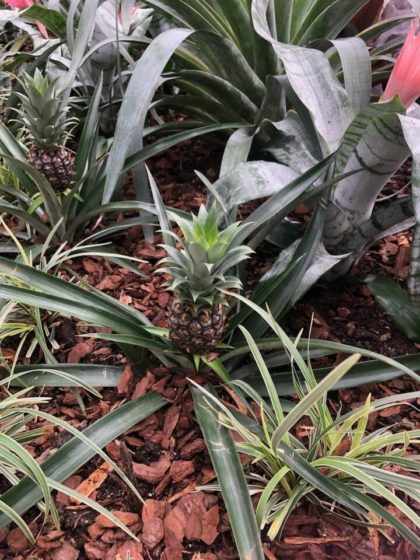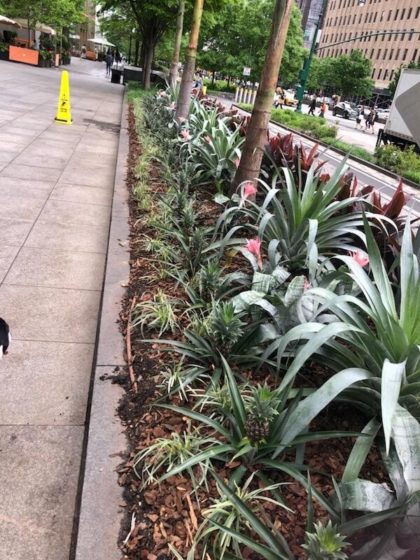Nosy Neighbor: What are pineapples doing along the Westside Highway?
Sonia Stock sent a note: “Strange — pineapples are growing alongside Goldman Sachs and Brookfield pathway. And they look like a decent size. They might be missing one in a month!”
Crazy! And so cute! And I thought — ’til now — only for the tropics.
It took a bit of toggling around via email to find the right folks — at first I thought they were the work of Tribecan and landscape architect Ken Smith, who did the Goldman gardens, and then I figured it was the BPCA — but in fact that is Brookfield property and the communications head there, Laura Montross, sent me to Mark Mini of John Mini Distinctive Landscapes, a 50-year-old firm based out of Congers and Long Island City that provides landscaping and garden design services for Brookfield Place. Mark filled me in. His explanation is thoughtful and thorough, so I will let him take it from here in Q&A form.
Are those regular old pineapples?
The scientific name of these plants producing pineapples is ‘Ananas comosus.’ They are part of the Bromeliaceae family. The Bromeliaceae family is commonly known as the bromeliad family, which, as noted, is a tropical plant typically used indoors to provide a variety of colors and textures. We commonly refer to them as pineapple bromeliads (real creative). They are the plant that produces the edible pineapples enjoyed around the world.
Can we eat them?
The ones we planted are grown for ornamental use and will sit along the Westside Highway for a couple months, thus we would not recommend harvesting and eating them.
What made you think to plant pineapples?
These pineapple bromeliads were integrated into Brookfield’s Westside Highway garden as part of our vision to transport New Yorkers and our visitors to a tropical oasis. The hustle and bustle of the Westside is interrupted for a moment, providing visitors and residents with a rejuvenating summer experience. This planting includes a combination of pineapple bromeliads, grasses, large foxtail fern palms, cordyline, and other varieties of bromeliads.
And why pineapples in particular?
Our team has a unique design advantage in that we have experience landscaping indoors and out in New York City. We have a network of nurseries that produce tropicals for indoor use (such as this pineapple bromeliad) and nurseries that supply New York zone appropriate natives, perennials, annuals, etc. Our team includes a horticulturalist versed in indoor and outdoor application. This versatility allows us to mix and match plants traditionally relegated to either indoor or outdoor use and develop unique plant palettes for Brookfield.
How are they able to grow here?
Late spring to early fall in New York provides temperature conditions suitable for these plants, though we’ll have to monitor and adjust a few other growing conditions such as humidity and irrigation. The pineapple bromeliads in particular won’t survive a New York winter. They’ll likely stay planted till mid-summer to early fall.
















Brookfield has the most beautiful gardens all year long. The tulips in the spring, the hydrangeas in the summer, and all the other beautiful interesting designs all year long. We are lucky to have such a generous neighbor.